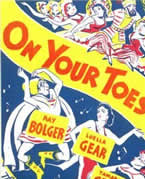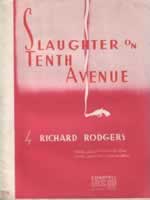On Your Toes 1936
 |
- Two-a-Day for Keith
- The Three B's
- It's Got to Be Love
- Too Good for the Average Man
- La Princesse Zenobia (ballet)
- The Heart Is Quicker than the Eye
- Quiet Night
- Glad to Be Unhappy
- On Your Toes
- Slaughter on Tenth Avenue (ballet)
Music by Richard Rodgers
Produced by Dwight Deere Wiman
Book by Richar Rodgers, Lorenz Hart & George Abbott
Directed by Worthington Miner (George Abbott unaccredited)
Choreoghraphy George Balachine
Starring: Ray Bolger, Luella Gear, Tamara Geva and Monty Woolley
It ran for 315 performances.
Junior Donal, an ex-vaudevillian now teaching music at Knickerbocker University, a WPA exention in New York, enlists to help of patroness Peggy Portefield to persuade Sergei Alexandrovich, the director of the Russian Ballet, to stage a friend's jazzy "Slaughter on Tenth Avenue" ballet. While he may dream of sharing the pleasure of a small hotel with girlfriend Frankie Frayne, Junior becomes involved with the company's prima ballerina, Vera Barnova, and even takes over the male lead in "Slaughter". This so enrages Vera'a lover and regular dancing partner that he hires two thugs to kill Junior while he is performing on stage. To avoid being a target Junior keeps dancing even after the ballet is over, then - once the gunmen have been arrested - falls exhausted to the floor.
 |
There have been two revivals of On Your Toes on Broadway In 1954, Abbott and Balanchine put together a production starring Bobby Van, Vera Zorina (she had appeared in the role of the ballerina in London and in the movie version) , and Elaine Stritch (who played Peggy and sang the interpolated "You Took Advantage of Me"). The general verdict was that the musical was hopelessly dated and it remained only two months.
Twenty-nine years later, however, again staged by Abbott, it succeeded so well that it bested the original Broadway run, Natalia Makarova of the American Ballet Theatre made an impressive Main Stem debut in the show. She was replaced during the engagement by ballerinas Galina Panova and Valentina Kozlova, and Dina Merrill was replaced by Kitty Carlisle, The 1939 movie, with Eddie Albert as Junior, used music only as background and for the ballets.
 |
| Ray Bolger, George Church and Tamara Geva dancing Slaughter on Tenth Avenue |
The shows of Richard Rodgers (1902-79) and Lorenz Hart (1895-1943) epitomized the wit and sophistication of Broadway musical comedy in its heyday -- approximately 1930 to 1940. While conceived primarily as sheer entertainment, the Rodgers & Hart musical comedies quickly developed a reputation for innovation as well. Their 1936 musical comedy ON YOUR TOES, a lighthearted look at the world of dance, was no exception in its innovative mark: ON YOUR TOES was the first Broadway musical to use dance as a direct proponent of the plot. Here, for the first time, choreography became a means, and not merely an end, to the storyline's narrative.
Since dance was essential to the story, a strong choreographer was needed. Rodgers, Hart and their director and co-author George Abbott took the radical step of hiring a renowned talent from the world of classical ballet -- the Russian-born co-founder of the New York City Ballet, George Balanchine -- to create their dances. "He didn't speak much English," recalled Rodgers years later, "but he spoke an awful lot of ballet."
 The
jewel in this musical comedy's crown is the climactic Act II ballet Slaughter
on Tenth Avenue. Ostensibly written by one of the characters in the show
(a WPA-funded struggling composer), it is an American ballet in the jazz
vernacular. In its storyline, a customer in a seedy Tenth Avenue strip
joint falls in love with a stripper, is discovered with her after closing
by the Big Boss and, in the violence that ensues, sees her killed by the
Big Boss. Not merely a showpiece, however, "Slaughter" is linked directly
to the musical through a plot device, thus forwarding two lines of narrative
at once. A dancer jealous of the ballet's leading man has hired two hit
men to kill him during a performance of "Slaughter"; the plot is uncovered
and our hero alerted but, until help arrives, he is forced to keep dancing
center stage and out of harm's way.
The
jewel in this musical comedy's crown is the climactic Act II ballet Slaughter
on Tenth Avenue. Ostensibly written by one of the characters in the show
(a WPA-funded struggling composer), it is an American ballet in the jazz
vernacular. In its storyline, a customer in a seedy Tenth Avenue strip
joint falls in love with a stripper, is discovered with her after closing
by the Big Boss and, in the violence that ensues, sees her killed by the
Big Boss. Not merely a showpiece, however, "Slaughter" is linked directly
to the musical through a plot device, thus forwarding two lines of narrative
at once. A dancer jealous of the ballet's leading man has hired two hit
men to kill him during a performance of "Slaughter"; the plot is uncovered
and our hero alerted but, until help arrives, he is forced to keep dancing
center stage and out of harm's way.
"Slaughter" is unique in the annals of American musical comedy; a recognized
ballet in its own right, it has entered the repertory of several leading
companies, particularly New York City Ballet. As an orchestral work, Rodgers'
superlative score for the ballet has become a staple with many symphony
and pops orchestras. Finally, while the musical has served to introduce
many theatre companies to the rigor of ballet, in 1990 the reverse was
true, when the world-famous Stuttgart Ballet of Germany premiered ON YOUR
TOES as the first musical in its repertoire
 |
A few weeks later in New York we ran into Lee Shubert and [his show coordinator] Harry Kaufman. The thing that had been keeping them up nights was the unhappy business of finding a vehicle for Ray Bolger. They thought he was star material. We, too, thought he was star material. Standing on the corner of Forty-fifth Street and Broadway we told Mr. Shubert and Mr. Kaufman the story of the hoofer and the Russian Ballet. They liked it, and this time there were no associates to be consulted. We concluded the deal standing there on the corner.
When the first draft of the book was finished we surveyed our work and found it was not so good. Anyway, be it said to our everlasting credit, we took the step of our own volition, without coaching from the managerial sidelines, and called in George Abbott. That was a lucky day. George straightened out the story line and kept it straight through the turmoil of production and the upheaval of out-of-town tryouts till the show emerged on the stage of the Imperial Theatre. The name would be "On Your Toes.'"
Richard Rodgers from: Words Without Music NEW YORK TIMES, June 14, 1936
On Your Toes original Broadway Revival 1954
On Your Toes London Studio Cast
Sheet music:
Cds: